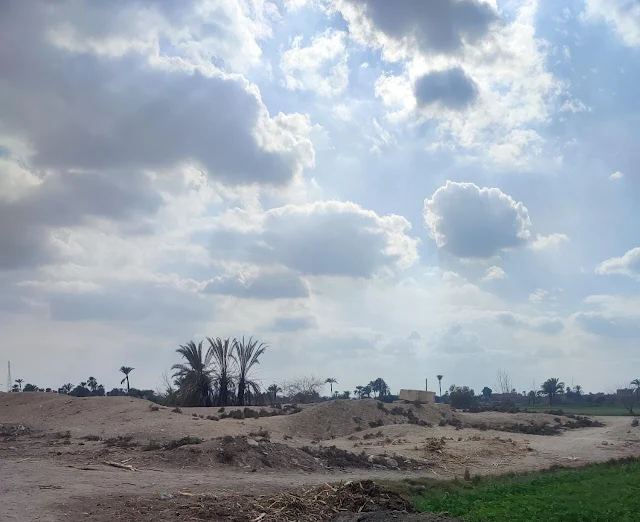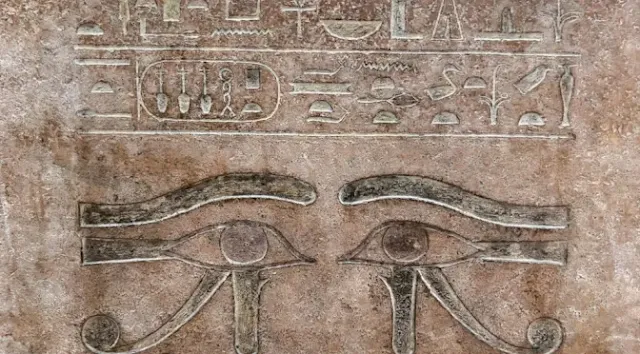Nefroptah | Nefroptah in Fayoum Egypt
Amenemhat III
Amenemhat III (Ancient Egyptian: Ỉmn-m-hꜣt meaning 'Amun is at the forefront'), also known as Amenemhet III, was a pharaoh of ancient Egypt and the sixth king of the Twelfth Dynasty of the Middle Kingdom. He was elevated to throne as co-regent by his father Senusret III, with whom he shared the throne as the active king for twenty years. During his reign, Egypt attained its cultural and economic zenith of the Middle Kingdom.
The aggressive military and domestic policies of Senusret III, which re-subjugated Nubia and wrested power from the nomarchs, allowed Amenemhat III to inherit a stable and peaceful Egypt. He directed his efforts towards an extensive building program with particular focus on Faiyum. Here he dedicated a temple to Sobek, a chapel to Renenutet, erected two colossal statues of himself in Biahmu, and contributed to excavation of Lake Moeris. He built for himself two pyramids at Dahshur and Hawara, becoming the first pharaoh since Sneferu in the Fourth Dynasty to build more than one. Near to his Hawara pyramid is a pyramid for his daughter Neferuptah. To acquire resources for the building program, Amenemhat III exploited the quarries of Egypt and the Sinai for turquoise and copper. Other exploited sites includes the schist quarries at Wadi Hammamat, amethyst from Wadi el-Hudi, fine limestone from Tura, alabaster from Hatnub, red granite from Aswan, and diorite from Nubia. A large corpus of inscriptions attest to the activities at these sites, particularly at Serabit el-Khadim. There is scant evidence of military expeditions during his reign, though a small one is attested at Kumma in his ninth regnal year. He also sent a handful of expeditions to Punt.
In total, Amenemhat III reigned for at least 45 years, though a papyrus mentioning a 46th year likely belongs to his reign as well. Toward the end of his reign he instituted a co-regency with Amenemhat IV, as recorded in a rock inscription from Semna in Nubia, which equates regnal year 1 of Amenemhat IV to regnal year 44 or 46–48 of Amenemhat III. Sobekneferu later succeeded Amenemhat IV as the last ruler of the Twelfth Dynasty.
PINK GRANITE SARCOPHAGUS WITH CURVED LID OF PRINCESS NEFERWPTAH
Neferwptah or Ptahneferu (“Beauty of Ptah”) was a daughter of the Egyptian king Amenemhat III of the 12th dynasty. Her sister was the Pharaoh Sobekneferu (“Beauty of Sobek”). Neferwptah is one of the first royal women whose name was written inside a cartouche. Although she never had the title 'king's wife', she must have had a special status; it is possible she was regarded as a future ruler. Her titles included a member of the elite, great of favour, great of praise and beloved king's daughter of his body.
A burial for her was prepared in the tomb of her father at Hawara. However, she was not buried there, but in a small pyramid at Hawara. Her tomb was found intact in 1956 and still contained her jewellery, a granite sarcophagus, three silver vases and other objects. The granite sarcophagus was inscribed with a short offering formula. Inside the sarcophagus were found the decayed remains of two wooden coffins. The outer one was decorated with inscribed gold foil. Identical inscriptions were found on the sarcophagus of Queen Hatshepsut, who lived about 300 years later. Her tomb is mentioned on a papyrus found at Lahun. She is depicted next to her father in the temple at Medinet Madi. Objects belonging to her include a sphinx of black granite and the fragment of a statue found on Elephantine. 12th dynasty. From Hawara, Fayum.
Neferuptah Jewellery
parts of Jewellery of Neferwptah collected from the sludgy material found in her sarcophagus show that her set of Jewellery was of the same type as those of most the Middle Kingdom burials found at Dahshûr and Lisht.
The magnificent broad collar (wesekh) that consists of three rows of blue-green feldspar and three rows of carnelian cylinder beads, separated by eight rows of small gold ring beads—all hung vertically. At the bottom is a fifteenth row of gold drops that are inlaid with carnelian, feldspar, and glass paste. The ends of the collar are formed by gold falcon-head terminals (or finials).
The elements of Jewellery which were found and could be restored most probably to their original state consisted of : 1.-a necklace of gold, carnelian and beads 2.-a broad collar 3.-a pair of bracelets and a pair of anklets 4.-a girdle of disc beads with a hawk-pendant 5.-A funerary apron of faience and blue frit beads
(Usekh) Collar of Neferuptah (or Ptahneferu) The Usekh is a type of broad collar or necklace. It was one of the most common types of ancient Egyptian jewelry. It could be composed of faience beads, flower petals, or gold with semi-precious stone or glass inlays. Six rows of beads terminate with the head of a golden falcon at each end; these were used as fasteners. Two smaller chains of beads are attached to the falcons, leading to a counterpoise, which also bears the image of a falcon, with further horizontal rows of beads hanging from it. At the bottom of the collar, teardrop shaped pendants can be seen, connected to a row of small golden beads. Neferuptah was a daughter of Amenemhat III (12th dynasty) 12th Dynasty
ca. 1860-1814 BC. Made of gold, carnelian, feldspar and glass paste From the small pyramid of Princess Neferuptah at Hawara National Museum of Civilization.
Funerary Apron of the Princess Neferuptah, Daughter of AMENEMHAT III. Middle kingdom.
Surface of the black granite offering table of Neferwptah
Burial of Neferwptah in Hawara
Neferwptah or Ptahneferu (“Beauty of Ptah”) was a daughter of the Egyptian king Amenemhat III of the 12th dynasty. Her sister was the Pharaoh Sobekneferu (“Beauty of Sobek”).
Neferwptah is one of the first royal women whose name was written inside a cartouche. Although she never had the title 'king's wife', she must have had a special status; it is possible she was regarded as a future ruler.
Her titles included a member of the elite, great of favour, great of praise and beloved king's daughter of his body.
A burial for her was prepared in the tomb of her father at Hawara. However, she was not buried there, but in a small pyramid at Hawara. Her tomb was found intact in 1956 and still contained her jewellery, a granite sarcophagus, three silver vases and other objects.











No comments:
Post a Comment